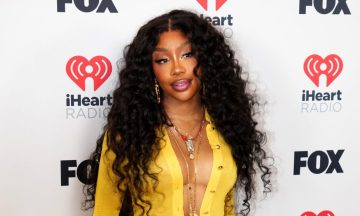
In honor of Hip Hop’s 50th Anniversary, The Shade Room would like to commemorate the moments, the pioneers, and the tools of the art form that have ultimately transcended the music genre, influencing every aspect of modern-day popular culture. Join us each week as we look back at five decades of hip hop.
RELATED: 50 Years Of Fiyah: A Look Back At Hip Hop In The 90s
To The Flo! Hip Hop Music Adopts Dance Craze Formula
By the early 2000s, hip hop was approaching 30 years of growth–in sound, business, and mainstream popularity. So, in addition to the experimental sounds that rounded out the decade came a trend we see today with music consumption on social media: trendy dances. Artists began pairing their hit songs with few-count moves.
In 2001, G. Dep and Diddy re-introduced hip hop fans to the popular 80s Harlem Shake in the video for “Special Delivery.” The dance also inspired DJ Webstar and Young B’s “Chicken Noodle Soup” (2006). Between 2012 and 2013, internet users adopted a watered-down version of the complex shoulder movement in the viral ‘Harlem Shake’ group challenge.
Chingy’s “Right Thur” (2003), the Ying Yang Twins’ “Salt Shaker” (2003), Fat Joe and Remy Ma’s “Lean Back” (2004), Lil Jon’s “Snap Yo Fingers” (2006) and Huey’s “Pop, Lock & Drop It” (2006) are some notable examples that ushered specific dance moves into hip hop culture.
DJ Unk’s “Walk It Out” (2007), GS Boyz’s “Stanky Legg,” and New Boyz’s “You’re A Jerk” (2009) still hold substantial playback value at kickbacks, cookouts, and club scenes. This era’s impact on dance moves is still seen in modern choreography.
Advanced Tech Skyrockets Hip Hop & Soulja Boy Becomes ‘Founding Father of Internet Fame’
Soulja Boy adopted a similar ‘dance craze’ formula with his debut single in 2007. If you let him tell it, he was the FIRST to achieve viral fame with “Crank That (Soulja Boy).” The catchy track came amid that transition from physical to digital music consumption. It reached number one on Billboard’s Hot 100 and stayed there for seven weeks.
Soulja Boy was about a decade ahead of what would become a norm for artists in today’s streaming and TikTok era. His career is one of the earliest examples of artists leveraging social media and the internet to promote their music via “challenges.”
After “Crank That” hit, so did videos of fans cranking it, including renditions of Batman, Superman, and Spongebob. Dozens of fan uploads landed on emerging user-friendly sites like YouTube and MySpace.
RELATED: Soulja Boy Jokingly Says There Would Be No TikTok If It Weren’t For Him
As mentioned, hip hop music was swept up by the changing dynamics of the 2000s. Physical mixtapes and CD albums started to find homes on online music services like iTunes (for purchase) and Limewire (for illegal downloads). YouTube, which began in 2005, was also a key player in the changing consumption space.
Such online services diminished the days of fans only relying on radio stations, DJs, or music shows like Yo! MTV Raps and BET’s106&Park and Rap City to hear their favorite tunes or see its music videos.
Starting this month, YouTube is running its FIFTY DEEP campaign, highlighting “two thousand Hip Hop videos that have changed the game.” The platform’s Director of Black Music & Culture, Tuma Basa, recently discussed why YouTube is “going hard to salute” the genre.
“Because Hip Hop has been poppin’ on YouTube dating back to when Soulja Boy’s “Crank That” video went viral in 2007. Since then, we’ve had trailblazers like Cardi B, Latto, Megan Thee Stallion, Nicki Minaj, SZA, and many more ruling our charts. Just last year, nine of the top ten artists in the U.S. were Hip Hop artists and collectively earned over 16 billion views globally,” Basa said.
Portable CD players also slowly began making a graceful exit. And MP3 players, like the first iPod in October 2001, ushered in a new way to consume hip hop on the go. Not only that, for plenty of hip hop artists, the iPod became a 2000s fashion accessory.
Experimental Sounds Find A Lane In Hip Hop
At the turn of the century, gangsta rap and conscious rap were arguably the most prominent sub-genres of hip hop. But the 2000s ushered in waves of experimental sounds, from snap rap to cross-genre duets, punchline rap, and mixtapes using existing beats (shoutout Lil Wayne).
Snap rap (also known as ringtone rap) brought a sense of fun and playfulness into rap that often led to commercialization and mainstream fame. It emerged in West Atlanta with influence from the 90s sub-genre crunk.
Though short-lived at the time, the subgenre was a vital influencer of the dance craze and was propelled by artists like D4L, Dem Franchize Boys, and K-Rab. Its influence is still seen in modern hip-hop artists like the Migos.
But the arguable lack of complex lyrics and bars being replaced by catchy verses and hooks didn’t sit well with everyone.
Nowadays, it seems like there’s a never-ending debate about “real” hip-hop music and how it’s supposed to sound and be created. But those critiques also have roots in the early 2000s when MCs were rapping about how to rap.
Take Slaughterhouse members–Joe Budden, Crooked I, Joell Ortiz, Royce da 5’9. Or Cassidy and Nas. All of which spoke on rappers’ pen games and lyrics during the 2000s.
Jay-Z, Kanye West & Missy Elliott: Soaring Success In The 2000s
Though Jay-Z found success in his music career throughout the 90s, the 2000s really saw the rapper soar to new heights. With a label, clothing brand, and five albums under his belt by the end of the 90s, the Brooklyn artist released hit-after-hit projects for the better part of the early 2000s.
Starting with Blueprint (2001) and culminating with The Blueprint 3 (2009), Jay dropped still highly-praised bops like “Izzo (H.O.V.A.),” “Excuse Me Miss,” “Girls Girls Girls,” and “99 Problems.”
The era, still thriving with remixes and cross-genre duets, also saw some of his most prominent features. From “Crazy In Love,” “’03 Bonnie & Clyde” and “Upgrade U” with Beyoncé to “Umbrella” with Rihanna and “Empire State of Mind” with Alicia Keys.
Jay-Z was also pivotal in Kanye West‘s (now known as Ye) transition from producing to spitting on the mic. Regarding experimental sounds, particularly soulful ones, Kanye was one of the innovators of that space. He started alongside industry heavy hitters like Jermaine Dupri, No I.D., and Deric “D-Dot” Angeletti.
His work on Jay-Z’s “Izzo (H.O.V.A.)”–sampling the Jackson 5 “I Want You Back”–made waves. Soon, his production (and pen game) were at the forefront.
Kanye’s debut album, College Dropout, came in 2004 and earned him multiple nominations and two Grammy wins at the 47th annual show. One was for Best Rap Album and the other Best Rap Song for “Jesus Walks.” His chipmunk soul sound, typically involving a sped-up sample, was prominently featured on the album’s “Through the Wire.”
Today, the rapper boasts 24 Grammy wins–tied with Jay-Z for the most wins in history.
Like Jay-Z and Ye, Missy Elliott slid through hip hop doors in the late 90s. But in the early 2000s, she established herself as a game-changer in hip hop.
While producing and penning some of the greatest hits for artists like Destiny’s Child, Whitney Houston, Aaliyah, and Mariah Carey, the creative also saved some genius for herself. Her first two albums, Supa Dupa Fly and Da Real World, came in the late 90s, but her third, Miss E…So Addictive came in 2001.
All three projects demonstrated the magic of her partnership with producer Timbaland, including their use of experimental, funky, and upbeat melodies and beats. Her tracks “One Minute Man” and the iconic “Get Ur Freak On” are core examples.
RELATED: WORK IT! Missy Elliott Becomes First Female Rapper Inducted Into Rock & Roll Hall Of Fame
Missy’s 2002 album Under Construction followed in its predecessors’ footsteps with hits like “Work It” and “Gossip Folks.” By 2005, Missy’s The Cookbook had its foot on fans’ necks, especially with the breakout single “Lose Control” and her unforgettable bars, “got a cute face, chubby waist, thick legs, in shape.”
Years ahead (and then on the verge) of YouTube, Missy also dominated the music video space with creative outfits and unmatched set designs.
In 2019, Missy Elliott became the first female rapper inducted into the Songwriters Hall of Fame. Both she and Jay-Z are the only rappers to be given the honor.
But to be clear, these three are far from the only artists who soared in the early 2000s. T-Pain was also a prominent figure, famously known for his autotune use. Pharrell, 50 Cent, T.I., Snoop Dogg, Andre 3000, Ludacris, Nelly, Cam’Ron, Remy Ma, Busta Rhymes, Yung Joc, Akon, and Gucci Mane are a small group amid other hip hop greats from the early 2000s.
Ja Rule, Ashanti, Irv Gotti & The Fall Of Murder Inc. Records
In 1998, brothers Irv and Chris Gotti founded the label Murder Inc. as a subsidiary of Def Jam. By then, Irv had established himself as a DJ, followed by a producer, and eventually, an A&R with Def Jam that signed both DMX and Ja Rule, per HotNewHipHop. Irv reportedly found inspiration for the label name from the crime group Murder Inc., which he had seen an A&E documentary on.
The label’s debut album, Ja Rule’s Venni Vetti Vecci, came in 1999 and went on to sell a million certified copies. Muder Inc.’s second release and first compilation album, Irv Gotti Presents: The Murderers, didn’t do as well the following year. But Ja Rule’s second album, Rule 3:36 (2000), and his third, Pain Is Love (2001), went triple platinum.
In 2001, Irv bagged Ashanti for the label, per Black Past. Like Ja, Ashanti shined at the label. Her self-titled debut album in 2002 sold three million units, certifying it platinum. The project won Best Contemporary R&B Album and earned two additional nominations at the 45th Annual Grammy Awards. Several of its songs peaked within the top 20 songs on the Billboard Hot 100, from “Foolish” to “Baby” and “Happy” featuring Ja Rule.
RELATED: Irv Gotti No Longer Sees Fat Joe As A ‘Brother’ After The Rapper Defended Ashanti: ‘You Don’t Even Know’
Two more albums came from the label in 2002, a part two compilation and Ja Rule’s fourth album, “The Last Temptation.” The first went gold, and Ja Rule’s was certified platinum.
But by 2003, the business started to turn sour when law enforcement raided the label’s offices. Eventually, in 2005, officials indicted Irv and Chris on money laundering and conspiracy charges. The brothers and their label Murder Inc.–just Inc. by then– were acquitted in Dec. 2005.
However, between the millions spent in legal fees, Ja Rule’s infamous beef with 50 Cent and later Eminem, and the departure of its top-selling artists, the label was practically non-existent by 2009. At its prime, the label was also home to Vita, Charli Baltimore, Black Child, and Lloyd.
















